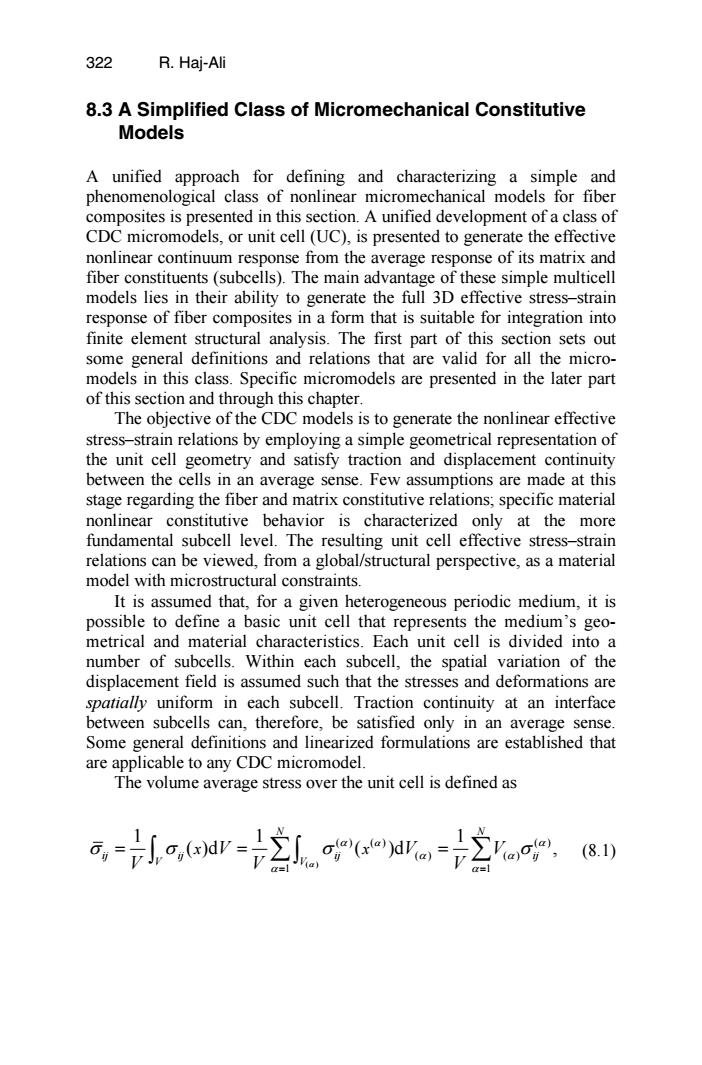正在加载图片...

322 R.Haj-Ali 8.3 A Simplified Class of Micromechanical Constitutive Models A unified approach for defining and characterizing a simple and phenomenological class of nonlinear micromechanical models for fiber composites is presented in this section.A unified development of a class of CDC micromodels,or unit cell (UC),is presented to generate the effective nonlinear continuum response from the average response of its matrix and fiber constituents(subcells).The main advantage of these simple multicell models lies in their ability to generate the full 3D effective stress-strain response of fiber composites in a form that is suitable for integration into finite element structural analysis.The first part of this section sets out some general definitions and relations that are valid for all the micro- models in this class.Specific micromodels are presented in the later part of this section and through this chapter. The objective of the CDC models is to generate the nonlinear effective stress-strain relations by employing a simple geometrical representation of the unit cell geometry and satisfy traction and displacement continuity between the cells in an average sense.Few assumptions are made at this stage regarding the fiber and matrix constitutive relations;specific material nonlinear constitutive behavior is characterized only at the more fundamental subcell level.The resulting unit cell effective stress-strain relations can be viewed,from a global/structural perspective,as a material model with microstructural constraints. It is assumed that,for a given heterogeneous periodic medium,it is possible to define a basic unit cell that represents the medium's geo- metrical and material characteristics.Each unit cell is divided into a number of subcells.Within each subcell,the spatial variation of the displacement field is assumed such that the stresses and deformations are spatially uniform in each subcell.Traction continuity at an interface between subcells can,therefore,be satisfied only in an average sense. Some general definitions and linearized formulations are established that are applicable to any CDC micromodel. The volume average stress over the unit cell is defined as 元,=,e业-2ea=2 (8.1)8.3 A Simplified Class of Micromechanical Constitutive Models A unified approach for defining and characterizing a simple and phenomenological class of nonlinear micromechanical models for fiber composites is presented in this section. A unified development of a class of CDC micromodels, or unit cell (UC), is presented to generate the effective nonlinear continuum response from the average response of its matrix and fiber constituents (subcells). The main advantage of these simple multicell models lies in their ability to generate the full 3D effective stress–strain response of fiber composites in a form that is suitable for integration into finite element structural analysis. The first part of this section sets out The objective of the CDC models is to generate the nonlinear effective stress–strain relations by employing a simple geometrical representation of the unit cell geometry and satisfy traction and displacement continuity between the cells in an average sense. Few assumptions are made at this stage regarding the fiber and matrix constitutive relations; specific material nonlinear constitutive behavior is characterized only at the more fundamental subcell level. The resulting unit cell effective stress–strain relations can be viewed, from a global/structural perspective, as a material model with microstructural constraints. It is assumed that, for a given heterogeneous periodic medium, it is number of subcells. Within each subcell, the spatial variation of the displacement field is assumed such that the stresses and deformations are spatially uniform in each subcell. Traction continuity at an interface between subcells can, therefore, be satisfied only in an average sense. Some general definitions and linearized formulations are established that are applicable to any CDC micromodel. The volume average stress over the unit cell is defined as ( ) () () ( ) ( ) ( ) 1 1 11 1 ( )d ( )d , N N ij ij ij ij V V x x V V V VV V α α α α α α α α σσ σ σ = = == = ∫ ∫ ∑ ∑ (8.1) R. Haj-Ali some general definitions and relations that are valid for all the micromodels in this class. Specific micromodels are presented in the later part of this section and through this chapter. possible to define a basic unit cell that represents the medium’s geometrical and material characteristics. Each unit cell is divided into a 322